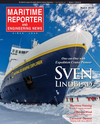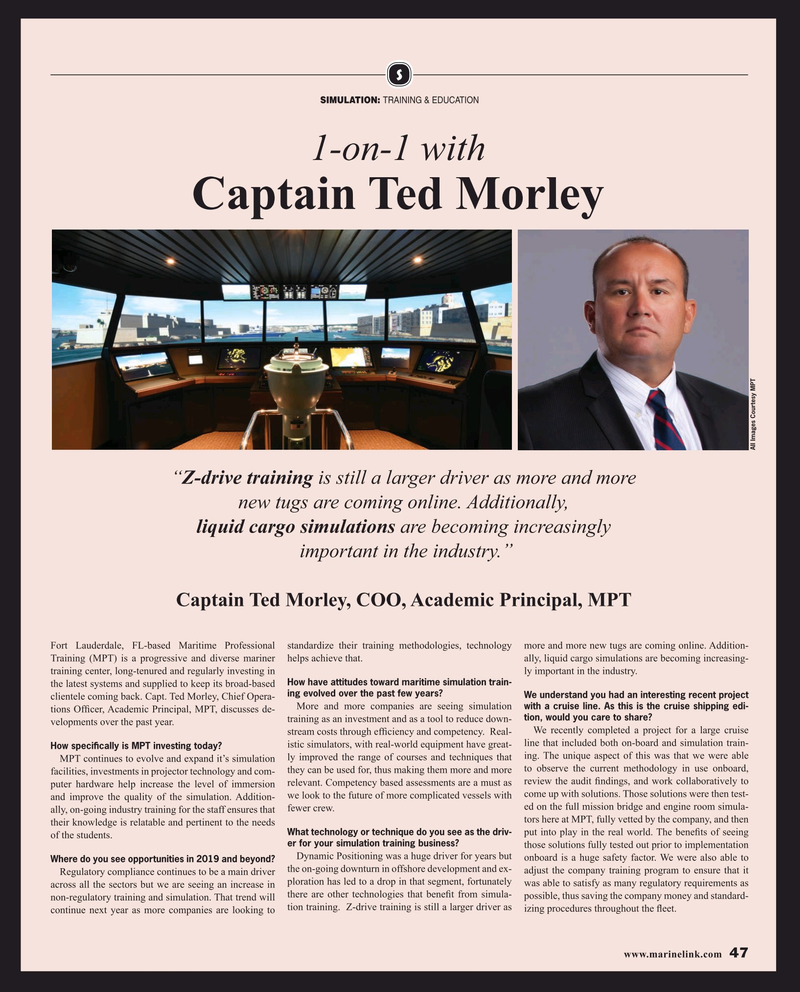
Page 47: of Maritime Reporter Magazine (March 2019)
Cruise Shipping
Read this page in Pdf, Flash or Html5 edition of March 2019 Maritime Reporter Magazine
S
SIMULATION: TRAINING & EDUCATION 1-on-1 with
Captain Ted Morley
All Images Courtesy MPT “Z-drive training is still a larger driver as more and more new tugs are coming online. Additionally, liquid cargo simulations are becoming increasingly important in the industry.”
Captain Ted Morley, COO, Academic Principal, MPT
Fort Lauderdale, FL-based Maritime Professional standardize their training methodologies, technology more and more new tugs are coming online. Addition-
Training (MPT) is a progressive and diverse mariner helps achieve that. ally, liquid cargo simulations are becoming increasing- training center, long-tenured and regularly investing in ly important in the industry.
How have attitudes toward maritime simulation train- the latest systems and supplied to keep its broad-based ing evolved over the past few years?
We understand you had an interesting recent project clientele coming back. Capt. Ted Morley, Chief Opera- with a cruise line. As this is the cruise shipping edi- More and more companies are seeing simulation tions Of? cer, Academic Principal, MPT, discusses de- tion, would you care to share?
training as an investment and as a tool to reduce down- velopments over the past year.
We recently completed a project for a large cruise stream costs through ef? ciency and competency. Real- line that included both on-board and simulation train- istic simulators, with real-world equipment have great-
How speci? cally is MPT investing today?
MPT continues to evolve and expand it’s simulation ly improved the range of courses and techniques that ing. The unique aspect of this was that we were able they can be used for, thus making them more and more to observe the current methodology in use onboard, facilities, investments in projector technology and com- puter hardware help increase the level of immersion relevant. Competency based assessments are a must as review the audit ? ndings, and work collaboratively to we look to the future of more complicated vessels with come up with solutions. Those solutions were then test- and improve the quality of the simulation. Addition- ed on the full mission bridge and engine room simula- ally, on-going industry training for the staff ensures that fewer crew. tors here at MPT, fully vetted by the company, and then their knowledge is relatable and pertinent to the needs
What technology or technique do you see as the driv- put into play in the real world. The bene? ts of seeing of the students. er for your simulation training business?
those solutions fully tested out prior to implementation Dynamic Positioning was a huge driver for years but onboard is a huge safety factor. We were also able to
Where do you see opportunities in 2019 and beyond?
the on-going downturn in offshore development and ex- adjust the company training program to ensure that it Regulatory compliance continues to be a main driver across all the sectors but we are seeing an increase in ploration has led to a drop in that segment, fortunately was able to satisfy as many regulatory requirements as possible, thus saving the company money and standard- non-regulatory training and simulation. That trend will there are other technologies that bene? t from simula- continue next year as more companies are looking to tion training. Z-drive training is still a larger driver as izing procedures throughout the ? eet. www.marinelink.com 47
MR #3 (42-49).indd 47 3/8/2019 3:41:41 PM

 46
46

 48
48
